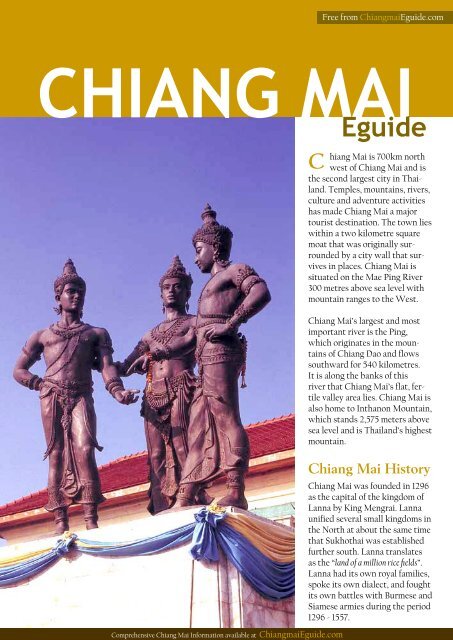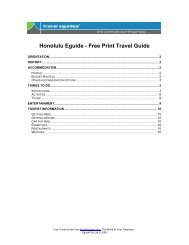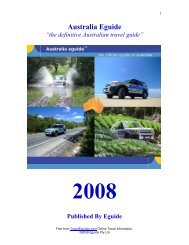You also want an ePaper? Increase the reach of your titles
YUMPU automatically turns print PDFs into web optimized ePapers that Google loves.
CHIANG MAI<br />
C<br />
Comprehensive <strong>Chiang</strong> <strong>Mai</strong> Information available at <strong>Chiang</strong>maiEguide.com<br />
Free from <strong>Chiang</strong>maiEguide.com<br />
Eguide<br />
hiang <strong>Mai</strong> is 700km north<br />
west of <strong>Chiang</strong> <strong>Mai</strong> and is<br />
the second largest city in Thailand.<br />
Temples, mountains, rivers,<br />
culture and adventure activities<br />
has made <strong>Chiang</strong> <strong>Mai</strong> a major<br />
tourist destination. The town lies<br />
within a two kilometre square<br />
moat that was originally surrounded<br />
by a city wall that survives<br />
in places. <strong>Chiang</strong> <strong>Mai</strong> is<br />
situated on the Mae Ping River<br />
300 metres above sea level with<br />
mountain ranges to the West.<br />
<strong>Chiang</strong> <strong>Mai</strong>’s largest and most<br />
important river is the Ping,<br />
which originates in the mountains<br />
of <strong>Chiang</strong> Dao and �ows<br />
southward for 540 kilometres.<br />
It is along the banks of this<br />
river that <strong>Chiang</strong> <strong>Mai</strong>’s �at, fertile<br />
valley area lies. <strong>Chiang</strong> <strong>Mai</strong> is<br />
also home to Inthanon Mountain,<br />
which stands 2,575 meters above<br />
sea level and is Thailand’s highest<br />
mountain.<br />
<strong>Chiang</strong> <strong>Mai</strong> <strong>History</strong><br />
<strong>Chiang</strong> <strong>Mai</strong> was founded in 1296<br />
as the capital of the kingdom of<br />
Lanna by King Mengrai. Lanna<br />
uni�ed several small kingdoms in<br />
the North at about the same time<br />
that Sukhothai was established<br />
further south. Lanna translates<br />
as the “land of a million rice �elds”.<br />
Lanna had its own royal families,<br />
spoke its own dialect, and fought<br />
its own battles with Burmese and<br />
Siamese armies during the period<br />
1296 - 1557.
<strong>Chiang</strong> <strong>Mai</strong> was attacked and fell<br />
under the control of King Bureng<br />
Nona of Myanmar in 1558 and<br />
then governed by a succession of<br />
Princes. In the 19th century, Rama<br />
V appointed a high commissioner<br />
in <strong>Chiang</strong> <strong>Mai</strong> and in 1939 <strong>Chiang</strong><br />
<strong>Mai</strong> came under the control of the<br />
central government in Bangkok.<br />
Reaching<br />
<strong>Chiang</strong> <strong>Mai</strong><br />
Flights are operated by an<br />
increasing number of airlines both<br />
domestic and international. The<br />
competition has led to reduced air<br />
fares in recent years. The airport<br />
is very close to the city centre.<br />
Most hotels offer a pick up service<br />
and if not, licensed taxis are available.<br />
There are many trains each<br />
day from Bangkok, with differing<br />
classes and speeds and averages 11<br />
hours.<br />
Alternatively use one of the air<br />
conditioned buses that leave<br />
Bangkok’s Northern Bus Terminal.<br />
The journey takes about nine<br />
hours over a distance of 696 kilometres<br />
passing Phra Nakhon Si<br />
Ayutthaya, Nakhon Sawan,<br />
Phitsanulok and Lamphun.<br />
<strong>Chiang</strong> <strong>Mai</strong><br />
Attractions<br />
For a complete list of <strong>Chiang</strong><br />
<strong>Mai</strong> attractions please visit<br />
<strong>Chiang</strong><strong>Mai</strong>eguide.com. Only the<br />
main attractions are listed and full<br />
details of each are available on the<br />
web site. <strong>Chiang</strong> <strong>Mai</strong> has a lot<br />
more to offer than listed here!<br />
<strong>Chiang</strong> <strong>Mai</strong> Night<br />
Safari<br />
A Safari style zoo with animals<br />
living in a reservation. The park<br />
is split into the Jaguar trail where<br />
you walk; Savanna Safari and<br />
Predator Prowl where you travel<br />
on a tram. The park is primarily<br />
designed for night<br />
time but is open during<br />
the day time.<br />
Doi Suthep<br />
Doi Suthep is the<br />
name of the hill and<br />
the temple is Wat<br />
Phra Borommathat<br />
Doi Suthep that<br />
sits on the top<br />
of the<br />
overlooking<br />
<strong>Chiang</strong><br />
<strong>Mai</strong>.<br />
Comprehensive <strong>Chiang</strong> <strong>Mai</strong> Information available at <strong>Chiang</strong>maiEguide.com<br />
The temple was built in 1383<br />
by King Gue Na and the legend<br />
is that an elephant was sent to<br />
search for a suitable location, it<br />
circled three times, trumpeted<br />
and fell on its knees at the place<br />
where the temple now is. Phu<br />
Ping Royal Palace is about 4 km<br />
from Wat Phrathat Doi Suthep on<br />
Doi Buak Ha.<br />
Mae Sa Valley<br />
Close to <strong>Chiang</strong> <strong>Mai</strong> is the Mae<br />
Sa valley about 30 minutes’ drive,<br />
where you will see the Mae Sa<br />
waterfall, orchid farm, monkey<br />
and snake farms and botanical<br />
gardens. You can also ride on the<br />
back of an elephant at the Mae Sa<br />
Elephant Camp.<br />
Doi Inthanon<br />
National Park<br />
The Park contains Thailand’s<br />
highest mountain at 2,565 metres.<br />
The Wachirathan, Siriphum and<br />
Mae Pan waterfalls share the<br />
mountain with Meo and Karen<br />
hill tribe settlements. You<br />
can drive all the way<br />
to the top,<br />
where stately<br />
chedis have<br />
been erected in<br />
honour of the<br />
present King<br />
and Queen of Thailand.<br />
The climate at the<br />
top is almost alpine and<br />
cool at all times of the<br />
year, with sub-zero<br />
temperatures in<br />
winter.
Wat Chedi Luang<br />
Located on Phraokklao Road, this<br />
temple is the site of an enormous<br />
pagoda, originally 280 feet high,<br />
which was partially destroyed by<br />
an earthquake in 1545. The temple<br />
was originally constructed in<br />
1401. It is one of the most sacred<br />
temples in <strong>Chiang</strong> <strong>Mai</strong>.<br />
Spas and Massage<br />
Thai massage provides therapeutic<br />
healing and the methods used<br />
today date back to Indian<br />
Ayurvedic practice developed by<br />
Buddhist monks 2000 years ago.<br />
Thai massage involves treating<br />
more than 100 areas of the body,<br />
using hand pressure and in particular<br />
the thumb.<br />
Oil Massage is gentler than Thai<br />
massage and involves deep muscle<br />
tissue treatment using specially<br />
blended therapeutic oils. Foot massage<br />
works the internal organs of<br />
the body through manipulation of<br />
pressure points on the soles of your<br />
feet. Massage parlours and Spas are<br />
found all over <strong>Chiang</strong> <strong>Mai</strong>.<br />
Wat <strong>Chiang</strong> Man<br />
Located on Ratchapakkinai Road,<br />
this is <strong>Chiang</strong> <strong>Mai</strong>’s oldest temple<br />
dating from 1296. The temple was<br />
the residence of King Mengrai and<br />
has a chedi supported by rows of<br />
elephantine buttresses, and a tiny<br />
crystal Buddha which is believe to<br />
have the power to bring rain.<br />
Comprehensive <strong>Chiang</strong> <strong>Mai</strong> Information available at <strong>Chiang</strong>maiEguide.com<br />
Trekking<br />
Popular treks last from 2 to 7<br />
days, take visitors through forested<br />
mountains and high valleys<br />
and meadows, and include visits<br />
to remote hill tribe settlements for<br />
overnight stays. Treks commonly<br />
feature travel by foot, sometimes<br />
by boat, elephant, horse or jeep,<br />
frequently a combination of two<br />
or three modes of transportation.<br />
Adventure<br />
The mountains and rivers of<br />
<strong>Chiang</strong> <strong>Mai</strong> provide opportunities<br />
to raft, walk, climb and bike. And<br />
for the more adventurous even<br />
Bungy jump and other extreme<br />
sports.<br />
Wat Phra Singh<br />
The largest Wat in <strong>Chiang</strong> <strong>Mai</strong><br />
dates from 1345 and notable for<br />
the Lai Kham chapel with<br />
woodcarvings and northern-style<br />
murals. The chedi was built in<br />
1345 to house the remains of King<br />
Kam Fu. Located at the end of<br />
Ratchadamnoen Road.
Walking Street<br />
<strong>Chiang</strong> <strong>Mai</strong> Walking Street is<br />
held every Sunday. The streets are<br />
closed to traf�c and vendors set<br />
up their stalls. The concept is to<br />
create a fun atmosphere where<br />
food and traditional plays a part<br />
in addition to the endless market<br />
stalls.<br />
Night Market<br />
Every night Chang Klan road<br />
between Tapee and Loh Kroh<br />
roads is lined with stalls selling<br />
a mix of handicrafts and general<br />
goods such as clothing, luggage<br />
and jewellery. Mixed in with the<br />
stalls are many restaurants,<br />
camera shops, travel agents and<br />
internet cafés.<br />
<strong>Chiang</strong> <strong>Mai</strong> Zoo<br />
<strong>Chiang</strong> <strong>Mai</strong> Zoo is located on<br />
Huay Kaew Road on a hilltop<br />
overlooking <strong>Chiang</strong> <strong>Mai</strong> with a<br />
large collection of animals and<br />
two recent pandas.<br />
Queen Sirikit<br />
Botanic Garden<br />
The highlight is the Glasshouse<br />
Complex, comprised of exhibition<br />
conservatories and display glasshouses.<br />
Plants are grouped<br />
together according to their environmental<br />
conditions, and the<br />
houses are each monitored to control<br />
light, humidity and ventilation.<br />
Copyright: Eguide Pty Ltd<br />
PO Box 1131, Noosaville<br />
Queensland 4566 Australia<br />
www.traveleguides.com<br />
Hill Tribes<br />
There are different hill tribes with<br />
their own traditions that live<br />
around <strong>Chiang</strong> <strong>Mai</strong>. The Karen,<br />
the largest group wear woven<br />
v neck tunics of various natural<br />
colours and turbans. The Hmong<br />
are the second largest hill tribe<br />
group and known for their intricate<br />
embroidery.<br />
The men wear baggy black pants<br />
with bright embroidery along the<br />
cuffs and seams. The Lahu women<br />
wear very distinctive black and<br />
red jackets and skirts and the men<br />
Comprehensive <strong>Chiang</strong> <strong>Mai</strong> Information available at <strong>Chiang</strong>maiEguide.com<br />
wear baggy green or blue pants.<br />
The Akha came from Yunnan,<br />
moving into Burma in the mid-<br />
19th century.<br />
Akha villages are distinguished<br />
by their carved wooden gates.<br />
Akha clothing is made of a homespun<br />
cotton cloth died black with<br />
indigo. The Yao live in isolated<br />
villages around <strong>Chiang</strong> Rai. The<br />
women are known for the long<br />
black jackets with red trim. The<br />
Paluang women beautify themselves<br />
by adding brass rings to<br />
their necks.




